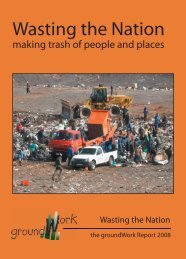Waste Incineration: A Dying Technology - GAIA
Waste Incineration: A Dying Technology - GAIA
Waste Incineration: A Dying Technology - GAIA
You also want an ePaper? Increase the reach of your titles
YUMPU automatically turns print PDFs into web optimized ePapers that Google loves.
to the manufacturer. Case studies show how these principles work in widely varying<br />
environments, such as a small maternity clinic in India and a major urban hospital in<br />
the United States.<br />
Industrial process wastes tend not to be as mixed as municipal or healthcare<br />
wastes, but many of them are chemically hazardous. Clean Production is an approach<br />
to industrial redesign that seeks to eliminate hazardous byproducts, reduce overall<br />
pollution, and create products and subsequent wastes that are safe within ecological<br />
cycles. The principles of Clean Production are:<br />
- the Precautionary Principle, which calls for precaution in the face of scientific<br />
uncertainty<br />
- the Preventive Principle, which holds that it is better to prevent harm than<br />
remediate it<br />
- the Democratic Principle, under which all those affected by a decision have the<br />
right to participate in decision-making<br />
- and the Holistic Principle, which calls for an integrated life-cycle approach to<br />
environmental decision-making.<br />
A variety of tools are being employed to implement Clean Production, from<br />
policy measures like right-to-know and tax reforms, to UN assistance to firms engaged<br />
in Clean Production.<br />
Clean Production cannot answer the problem of existing stockpiles of<br />
hazardous wastes, which need some form of treatment besides incineration. A number<br />
of programs are developing technologies to address this problem. The standards that<br />
have evolved for such technologies are:<br />
- high destruction efficiencies<br />
- containment of all byproducts<br />
- identification of all byproducts<br />
- and no uncontrolled releases.<br />
Several emerging technologies fit these criteria, and have been selected in Japan,<br />
Canada and Australia for PCB destruction, and in the United States for chemical weapons<br />
destruction. The U.S. chemical weapons program is a success largely because of strong<br />
public participation, which pushed an unwilling government to investigate and<br />
eventually select safer, non-incineration technologies.<br />
Section 3: Putting Out the Flames<br />
Section 3 discusses the growing rejection of incineration across the globe. Public<br />
opposition has killed many proposed and existing incinerators, and is being<br />
incorporated into local, national and even international law. Popular resistance to<br />
incinerators is global: hundreds of public interest organizations in dozens of countries<br />
are engaged in the fight against incineration and in favor of alternatives.<br />
In the United States, business interests and a perceived landfill crisis drove an<br />
incinerator building boom in the 1980s. But the boom spawned a massive grassroots<br />
movement that defeated more than 300 municipal waste incinerator proposals. The<br />
activists fought for higher emission standards and removal of subsidies, which virtually<br />
shut down the industry by the end of the 1990’s.<br />
4 <strong>Waste</strong> <strong>Incineration</strong>: A <strong>Dying</strong> <strong>Technology</strong>

















